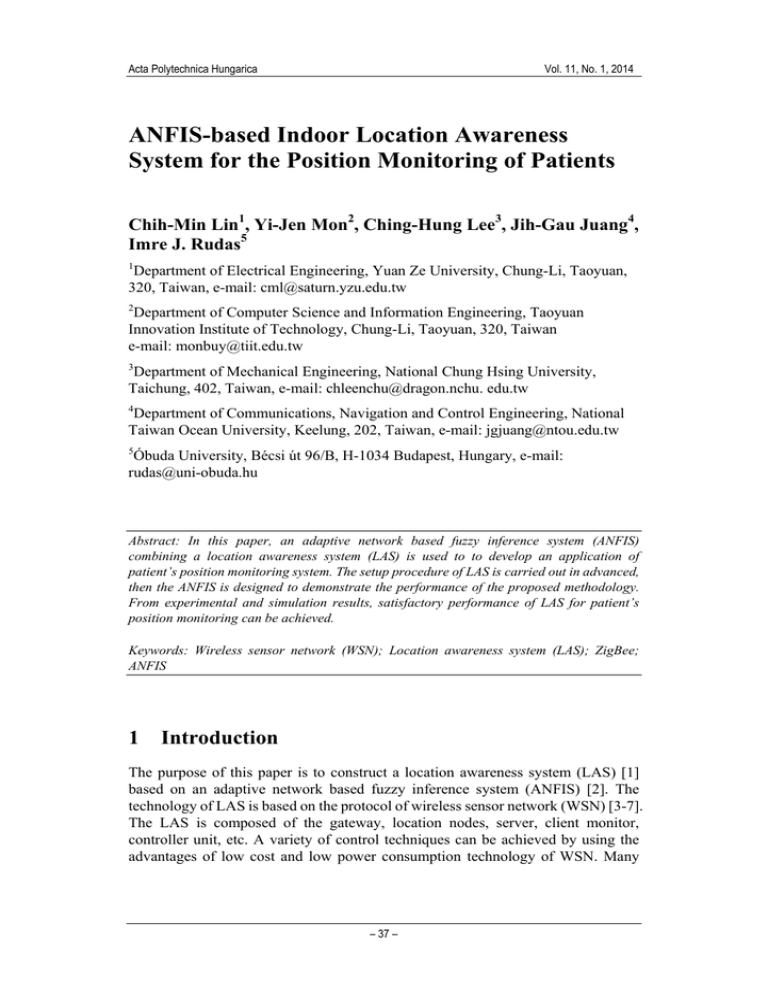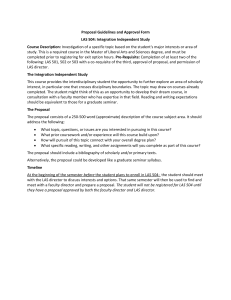ANFIS-based Indoor Location Awareness System for the Position Monitoring of Patients
advertisement

Acta Polytechnica Hungarica Vol. 11, No. 1, 2014 ANFIS-based Indoor Location Awareness System for the Position Monitoring of Patients Chih-Min Lin1, Yi-Jen Mon2, Ching-Hung Lee3, Jih-Gau Juang4, Imre J. Rudas5 1 Department of Electrical Engineering, Yuan Ze University, Chung-Li, Taoyuan, 320, Taiwan, e-mail: cml@saturn.yzu.edu.tw 2 Department of Computer Science and Information Engineering, Taoyuan Innovation Institute of Technology, Chung-Li, Taoyuan, 320, Taiwan e-mail: monbuy@tiit.edu.tw 3 Department of Mechanical Engineering, National Chung Hsing University, Taichung, 402, Taiwan, e-mail: chleenchu@dragon.nchu. edu.tw 4 Department of Communications, Navigation and Control Engineering, National Taiwan Ocean University, Keelung, 202, Taiwan, e-mail: jgjuang@ntou.edu.tw 5 Óbuda University, Bécsi út 96/B, H-1034 Budapest, Hungary, e-mail: rudas@uni-obuda.hu Abstract: In this paper, an adaptive network based fuzzy inference system (ANFIS) combining a location awareness system (LAS) is used to to develop an application of patient’s position monitoring system. The setup procedure of LAS is carried out in advanced, then the ANFIS is designed to demonstrate the performance of the proposed methodology. From experimental and simulation results, satisfactory performance of LAS for patient’s position monitoring can be achieved. Keywords: Wireless sensor network (WSN); Location awareness system (LAS); ZigBee; ANFIS 1 Introduction The purpose of this paper is to construct a location awareness system (LAS) [1] based on an adaptive network based fuzzy inference system (ANFIS) [2]. The technology of LAS is based on the protocol of wireless sensor network (WSN) [3-7]. The LAS is composed of the gateway, location nodes, server, client monitor, controller unit, etc. A variety of control techniques can be achieved by using the advantages of low cost and low power consumption technology of WSN. Many – 37 – C-M. Lin et al. ANFIS-based Indoor Location Awareness System for the Position Monitoring of Patients applications of WSN have been developed successfully. The well known WSN is based on the IEEE 802.15.4/ZigBee standard to define the layers of network so as to achieve benefits of low cost and low power consumption. The indoor LAS uses the received signal strength indication (RSSI) method to determine the estimated distances of each location of sensor node [6], then uses a least-squares trilateration (LST) algorithm [7] to calculate the concerned node location. The most attractive advantage of indoor LAS is that it can substitute the global positioning system (GPS) for indoor positioning applications. This is because the GPS can not receive / transmit any satellite signals indoor because of many obstacles of building. The LAS has been used in many university or institute for the research purpose; this LAS is named i-Tracer system produced by Fontal Technology Inc. Taiwan [2]. By using the i-Tracer, many indoor LAS applications can be developed. In this paper, the patient’s position monitoring methodology is proposed. ANFIS has been proposed many years ago and widely used in research works [2]. It reveals an efficient learning network and its applications can be found in many articles. ANFIS is a suitable off-line hybrid learning network to serve as a basis for constructing a set of fuzzy if-then rules with appropriate membership functions to generate the stipulated fuzzy associated memory (FAM) input-output pairs and fuzzy rules. Then a fuzzy inference system (FIS) matrix can be achieved. By using this FIS matrix, a reliable controller can be designed. The MATLAB™ has provided very useful, powerful and friendly tools for engineers to design this ANFIS controller [8]. The research topics about patient’ applications have been grown recently due to the great interest among people. Some topics have been developed such as health insurance system [9], advisory decision monitoring patients system [10] or remote health monitoring system [11], recognizing of human activity system [12] and nursing homes for elderly patients system [13]. The above mentioned articles have demonstrated good and useful benefits for patients’ applications. Based on this reason, LAS is used and is combined with ANFIS to develop the position monitoring system for some special requirements of patients. In this paper, the LAS will be demonstrated first then it will be applied for the patient’s position monitoring. In empirical test, good performance of position monitoring of LAS are possessed. This method also takes great benefits for reducing many burdens of nurses or doctors for caring the patients’ positions. 2 Anfis-based Location Awareness System (LAS) An indoor LAS considers only indoor environments such as inside a building. The location of users or their devices called ‘Tag’ can be determined by the server of – 38 – Acta Polytechnica Hungarica Vol. 11, No. 1, 2014 LAS. From this definition, LAS can work all the day and can offer useful position information of the ‘Tag’ of LAS. The LAS used in this paper is called i-Tracer, it can calculate the signal path loss due to signal propagation attenuation or RSSI. For example, if there are three location nodes, three path losses can be denoted as pl1 , pl2 and pl3 , the location of tag ‘A’ can be calculated by means of Least-Squares Trilateration (LST) methodology as shown in Fig. 1. The values of path losses or RSSI will be varied according to the distances between the Tags and location nodes. Near distance will induce larger RSSI value and vice versa. All data can be stored in the database of LAS by Structured Query Language (SQL) and Java language programs. The LAS is constructed by 3 servers to manage the data processing, positioning and monitoring. LN1 LN3 pl1 pl3 A pl2 LN2 Figure 1 The concept diagram of least-squares trilateration (LST) The ANFIS is a useful tool developed by intelligent learning algorithm to identify the membership function’s parameters to generate reliable fuzzy inference systems (FIS). It uses the method of least-squares methods to train FIS membership function parameters from a given training input/output data set. The principle of ANFIS is described below [2]: Ri : If x1 is Ai1 …and xn is Ain then ui pi1x1 .. pin xn ri (1) where Ri denotes the ith fuzzy rules, i=1, 2,..,j; Aik is the fuzzy set in the antecedent associated with the kth input variable at the ith fuzzy rule; and pi1,..., pin , ri are the fuzzy consequent parameters. Based on the weighted averaged method of defuzzification, the output u can be calculated as – 39 – C-M. Lin et al. u ANFIS-based Indoor Location Awareness System for the Position Monitoring of Patients wj w1 u1 .. u j w1u1 .. w j u j w1 .. w j w1 .. w j (2) where wi is the ith node output firing strength of the ith rule; and w1 wj w1 ,.., w j . w1 .. w j w1 .. w j Because the fuzzy inference system is a Takagi-Sugeno (T-S) type, i.e. ui pi1x1 .. pin xn ri , equation (2) can be rewritten as u w1u1 .. w j u j ( w1x1 ) p11 .. ( w1xn ) p1n ( w1 )r1 ( w j x1 ) p j1 .. ( w j xn ) p jn ( w j )r j . (3) A neural network structure of ANFIS is shown in Fig. 2. There are five layers which includes input layer, input membership function layer, rule layer, output membership function layer and output layer. All the parameters of layers can be trained by typing command in MatlabTM window. By means of ANFIS-based control methodology, the designed methodology can be carried out. The overall design conceptual diagram is shown in Fig. 3. Figure 2 Diagram of ANFIS architecture – 40 – Acta Polytechnica Hungarica Vol. 11, No. 1, 2014 Patients’ positions Tags RSSI Threshold Server and Location nodes Alarm Inference values ANFIS Monitor Alarm Devices SQL database ANFIS based LAS Figure 3 Conceptual diagram of ANFIS based LAS for patient’s position monitoring 3 3.1 Experiment and Simulation Results Experiments Implementation For the experimental tests, the aforementioned values of path loss or RSSI will be varied according to the distance between the location nodes and tags. One of the LAS experimental results diagram is shown in Fig. 4, the tag is worn on the puppet neck. The LAS is constructed by 3 location nodes to manage processing data and monitoring tag’s location. The experimental test is carried out by using three location nodes and one tag. At first, the gateway should be connected successfully; then the message diagram of LAS is shown in Fig. 5. It shows that one gateway and three location nodes are setup successfully. One of experimental tests of Tag of ‘9043’ is located near location node 3 which is shown in Fig. 6. This diagram is corresponding to Fig. 4 (a). The tag number will be displayed beside the nearest location node. In this program, the actual analogue to digital (A/D) value will be normalized as hexadecimal values from 0x00 to 0xFF. Finally, data of the LAS experiment results diagram is shown in Fig. 7, the tag of number ‘9043’ is near the – 41 – C-M. Lin et al. ANFIS-based Indoor Location Awareness System for the Position Monitoring of Patients location node 3. By using i-Tracer graphic user interface (GUI), the data can be appeared in the screen and stored in database of SQL. From Fig. 7, for example, the first socket data begins with label of #31 is useful; the meaning of the first string received in the first line of Fig. 7 is explained by marked in bold as follows: #31;9043;04;0008;2493;E4;0008;0000;B4;0008;0001;96;0008;124A;90;2D. (4) It means that the Tag number is ‘9043’ and it has received four hexadecimal values of path loss or RSSI, these are E4, B4, 96 and 90, respectively. All these data will be stored in database by SQL program and can be fed to ANFIS system to construct a patient’s position monitoring system. The SQL database is installed successfully and can be started to work such as in Fig. 8. 3.2 Simulation Demonstration For the simulation, the position data should be got in advance. So LAS must be set up appropriately at first. From the concept of Fig. 1 to Fig. 3, the path loss values or RSSI between tag and location nodes will be stored in LAS server. All necessary data can be achieved by using SQL language program such as in Fig. 8. In simulation, one tag is extended to three tags which are used to verify the proposed monitoring methodology. For simplicity, one case is explained as follows. One of the simulation results are shown in Fig. 9. The inference ANFIS output value is normalized from 0 to 1. If the patient’s position is away from the suitable position, the ANFIS value will be reduced down; on the contrary, if the patient’s position is near the indicated position, the ANFIS value will be high. If the value is lower than the threshold value, then the alarm signals such as sound, image or light will be issued. In this condition, nurses or doctors can take care or pay more attentions to that patient. For example, from Fig. 9 (a) of this simulation, patient of tag 1 has left his room; the ANFIS will alarm the signal because it has low fuzzy inference value HC= 0.0167 which is lower than the threshold value of 0.5. On the other hand, when all patients are in rooms the result is shown in Fig. 9 (b), it has high fuzzy inference value HC= 0.981; the ANFIS will not alarm any signals. The ANFIS-based LAS for patient’s position monitoring in this paper just illustrate an example of patient’s position monitoring. There are many other applications can be developed by this LAS such as smart light systems, intelligent indoor navigation systems and firefighting rescue systems, etc. From this example, it demonstrates that the experimental and ANFIS-based LAS simulations have been successfully established; meanwhile, the good patient’s position monitoring performance is achieved. Normally, three location nodes are necessary for the LAS, but if the accuracy of system is an important issue, more location nodes can be used to increase the accuracy of this system. – 42 – Acta Polytechnica Hungarica Vol. 11, No. 1, 2014 Figure 4(a) The architecture photograph of LAS Location node 1 (Area 1) LAS Server Location node 3 (Area 3) Low RSSI High RSSI Tag Gateway Low RSSI Location node 2 (Area 2) Figure 4(b) The concept diagram of LAS – 43 – C-M. Lin et al. ANFIS-based Indoor Location Awareness System for the Position Monitoring of Patients Figure 5 The successful connection diagram of LAS Figure 6 The diagram of LAS for Tag of ‘9043’ is located in location node 3 – 44 – Acta Polytechnica Hungarica Vol. 11, No. 1, 2014 Figure 7 Diagram of implementation of i-Tracer graphic user interface (GUI) Figure 8 Diagram of SQL database working for LAS – 45 – C-M. Lin et al. ANFIS-based Indoor Location Awareness System for the Position Monitoring of Patients Figure 9 (a) The ANFIS inference result diagram (patient 1 has left the room) Figure 9 (b) The ANFIS inference result diagram (all patients are in rooms) – 46 – Acta Polytechnica Hungarica Vol. 11, No. 1, 2014 Conclusion In this paper, the design method for the application of patient’s position monitoring by using the adaptive network based fuzzy inference system (ANFIS) based location awareness system (LAS) is proposed. This study has successfully demonstrated the application of the LAS to monitor the location of patients. The physical implementations and simulations are also successfully demonstrated, which show this system has possessed the good performance of ANFIS-based LAS for the position monitoring of patients. References [1] i-Tracer User Guide, Fontal (http://www.fontaltech.com.tw) [2] J. S. R. Jang, “ANFIS: Adaptive-Network-based Fuzzy Inference System,” IEEE Transactions on Systems, Man and Cybernetics, Vol. 23, pp. 665-685, 1993 [3] P. Baronti, P. Pillai, V. W. C. Chook, S. Chessa, A. Gotta, Y. F. Hu, “Wireless Sensor Networks: A Survey on the State of the Art and the 802.15.4 and ZigBee Standards,” Computer Communications, Vol. 30, pp. 1655-1695, 2007 [4] Y. J. Mon, C. M. Lin, I. J. Rudas, “Wireless Sensor Network (WSN) Control for Indoor Temperature Monitoring,” Acta Polytechnica Hungarica, Vol. 9, No. 6, pp. 17-28, 2012 [5] Y. J. Mon, C. M. Lin, I. J. Rudas, “ANFIS-based Wireless Sensor Network (WSN) Applications for Air Conditioner Control,” Acta Polytechnica Hungarica, Vol. 10, No. 3, pp. 5-16, 2013 [6] Y. J. Mon, “The Distance Measurement by Using RSSI of Wireless Sensor Network,” International Journal of Computational Engineering Research, Vol. 3, No. 4, pp. 110-112, 2013 [7] K. Lu, X. Xiang, D. Zhang, R. Mao and Y. Feng, “Localization Algorithm Based on Maximum a Posteriori in Wireless Sensor Networks,” International Journal of Distributed Sensor Networks, Article ID 260302, 2012 (DOI:10.1155/2012/260302) [8] MATLAB User Guide, Mathworks Inc., 2012 (http://www.mathworks.com) [9] M. F. Abbod, D. G. Keyserlingk, D. A. Linkens, M, Mahfouf, “Survey of Utilisation of Fuzzy Technology in Medicine and Healthcare,” Fuzzy Sets and Systems, Vol. 120, pp. 331-349, 2001 [10] J. Bajo, J. F. Paz, Y. Paz, J. M. Corchado, “Integrating Case-based Planning and RPTW Neural Networks to Construct an Intelligent Environment for Health Care,” Expert Systems with Applications, Vol. 36, pp. 5844-5858, 2009 – 47 – Technology Inc., Taiwan, 2013 C-M. Lin et al. ANFIS-based Indoor Location Awareness System for the Position Monitoring of Patients [11] J. C. Huang, “Remote Health Monitoring Adoption Model Based on Artificial Neural Networks,” Expert Systems with Applications, Vol. 37, pp. 307-314, 2010 [12] Y. J. Mon, “Health Care Activity Map Designed by Fuzzy Neural Network,” Advanced Science, Engineering and Medicine, Vol. 4, pp. 355-359, 2012 [13] M. P. Rajasekaran, S. Radhakrishnan, P. Subbaraj, “Sensor Grid Applications in Patient Monitoring,” Future Generation Computer Systems, Vol. 26, pp. 569-575, 2010 – 48 –


